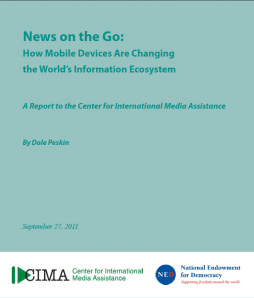A new report from the Center for International Media Assistance (CIMA) at the National Endowment for Democracy “examines questions about how a global information society might look with mobile media devices at its hub.” The report, News on the Go: How Mobile Devices Are Changing the World's Information Ecosystem, is available for download here.
According to the report, at the end of 2010, more than 4 billion people paid for mobile serivce. By the end of this year, about 5 billion mobile phones will be in service in a world with 7 billion people. The report suggests that the implications of so many people having access to phones are many: for politics, for education, for economies, for civil society, and for news and information.
While it offers several examples of mobile case studies in these various issue areas, the report focuses primarily on the growth of mobile Internet, and, hence, high-end smart phones over basic feature phones.
At MobileActive.org and on the Mobile Media Toolkit, we write often about the role of and potential for the basic feature phone. The CIMA report takes the stance that while 5 billion people will have access to mobile phones, by the end of this year “virtually every phone sold” will be a more high-end device.
“Many will be phones with limited capabilities, but technologies are becoming so cheap that by the end of this decade virtually every phone sold will be what we now call a smart phone: a mobile communcations device that goes beyond voice calls and has the capacity to run computer applications, send and receive e-mail, pinpoint locations via global positioning systems, and more.”
The Tools for Mobile Media section of the report links to case studies in mobile media, many of which come from the Mobile Media Toolkit:
- Avaaj Otalo: a voice-based community forum that connects farmers in India to relevant and timely agricultural information over the phone.
- CGNet Swara: a citizen journalism channel in India that allows people to call a local phone number to listen to news content.
- Young Africa Live: a South African mobile portal where users can access information about HIV/AIDS.
- Freedom Fone at Farm Radio Stations in Africa: a service that leverages audio as a mobile function to engage with radio listeners and share vital agricultural information.
- Bubbly: an audio-blogging service that is popular in India.
- Gaon Ki Awaaz: a twice-daily news alert that is delivered via voice call to subscribers’ phones in India.
- Radio Azadi in Afghanistan: a service that provides interactive SMS service to access content and participate in the program via mobile phone.
- Rede Jovem: a Wikimap project that uses citizen reports to map favelas, or shanty towns, in Rid de Janeiro.
- Jasmine News: a sevice that sends SMS news headlines to subscribers in Sri Lanka.
- Voices of Africa Media Project: a project that teaches young journalists in Africa how to create content on their mobile phones.
More case studies are available at the Mobile Media Toolkit.
The report is forward-looking, in line with its emphasis on mobile Internet and growing smart phone penetration. The report suggests that the above-mentioned “projects are modest in scope, the beginnings of farther-reaching experiments in mobile media development that will emerge with increasingly more sophisticated applications on the mobile phones that most of the world’s population will carry.”
The report includes a short section on the cultural factors associated with mobile as a hub for world communication. “In the end, the mobile Internet is more a social phenomenon than a technological one.”
The News on the Go report concludes:
Let it happen. Participatory democracy demands participation. Those who promote democracy and indpendent media should take up the agenda of citizens who are experimenting with new possibilites and different outcomes. This might mean a shift, or at least a new emphasis, on media assistance to independent and entreprenuerial journalists, as well as to technologists.
Download a complete copy of the CIMA report here.


Post new comment